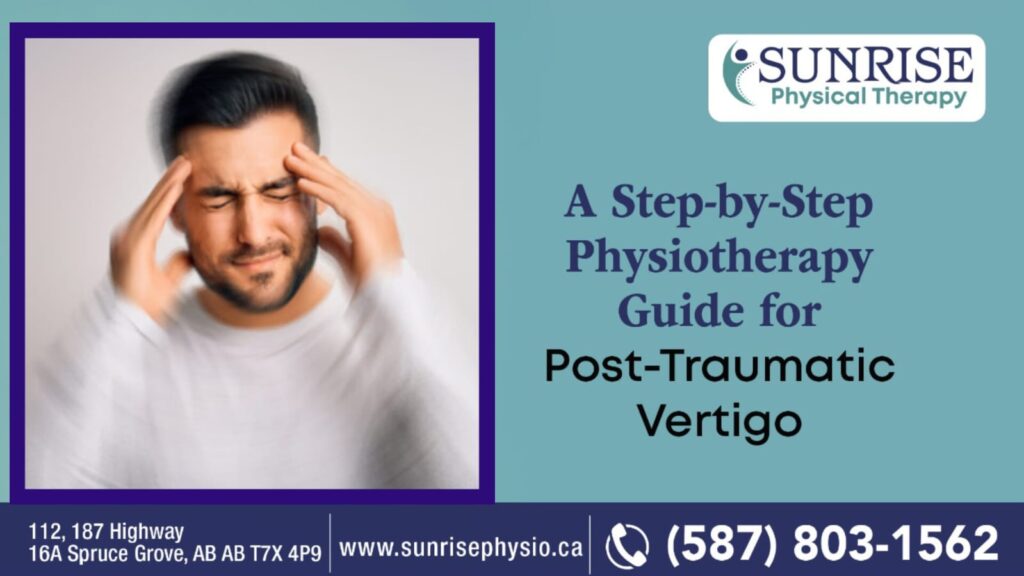Post-traumatic vertigo can be a disorienting and challenging condition to manage, often resulting from head injuries that disrupt the inner ear’s balance mechanisms. To address this condition effectively, a step-by-step approach to physiotherapy is essential. Vestibular physiotherapy in Spruce Grove offers targeted interventions designed to alleviate symptoms and improve balance. This specialized form of vertigo physiotherapy focuses on retraining the brain to process balance information correctly, helping patients regain stability and reduce episodes of dizziness.
By following a structured rehabilitation guide, patients can significantly improve their symptoms, enhance their ability to perform day-to-day activities and improve their overall quality of life.
Comprehensive Assessment
- History Taking: A detailed interview to collect data on the nature of the trauma, the onset of vertigo, previous medical history, and lifestyle factors that could influence recovery.
- Symptom Analysis: Understanding the specific symptoms such as dizziness, balance issues, and nausea to tailor the therapy effectively.
- Observation and Physical Tests: Analyzing posture, balance, gait, and the coordination between eye and head movements.
- Vestibular Specific Assessments: Employing tests like the Dix-Hallpike maneuver, which involves observing the eyes for abnormal movements while moving the patient from sitting to lying down quickly with the head in specific positions.
- Technological Assessments: Further diagnostics may include videonystagmography (VNG) or rotary chair testing if available and indicated.
Personalized Treatment Planning
- Setting Realistic Goals: These may include specific milestones such as reducing the frequency of vertigo episodes, improving balance, and increasing confidence in daily activities.
- Scheduling: Deciding on the number and frequency of sessions required based on the severity of symptoms and patient availability.
Targeted Rehabilitation Techniques
Gaze Stabilization Exercises
Purpose and Impact: Gaze stabilization exercises are designed to improve the Vestibulo-Ocular Reflex (VOR), which is essential for maintaining clear vision during head movements. This reflex helps compensate for head movements, ensuring that vision remains stable and focused.
Examples of Exercises:
- Fixed Point Focus: The patient focuses on a single point while moving their head horizontally or vertically. This helps train the brain to maintain focus despite movements, which can be crucial in environments with varying sensory input.
- VOR X1 and VOR X2 Exercises: In VOR X1, the patient moves their head side to side or up and down while keeping their gaze fixed on a target. In VOR X2, the target moves in the opposite direction of the head, adding complexity to the exercise.
Balance Enhancement Exercises
Purpose and Impact: These exercises are crucial for improving proprioception and the overall ability to maintain balance when stationary or moving. Strengthening balance is particularly important for individuals with post-traumatic vertigo, as it helps prevent falls and improves confidence in daily activities.
Examples of Exercises:
- One-Foot Stand: Practicing standing on one foot enhances balance and strengthens the leg muscles.
- Heel-to-Toe Walk: Walking in a linear path with one foot in front of the other, often referred to as a “tandem walk,” challenges balance and coordination.
- Balance Boards: Using devices like balance boards or wobble boards can advance balance training by introducing dynamic elements that mimic real-world scenarios.
Habituation Exercises
Purpose and Impact: Habituation exercises are intended to reduce the sensitivity to movement that triggers vertigo symptoms. By repeatedly exposing the patient to these movements in a controlled manner, the brain learns to cope with them and eventually ignores the dizzy sensations associated with them.
Examples of Exercises:
- Repetitive Head Movements: Simple exercises like nodding or shaking the head can trigger symptoms initially but gradually lead to a decrease in vertigo episodes.
- Positional Changes: Quickly changing from sitting to standing or turning around can provoke vertigo, and controlled exposure to these movements helps desensitize the vestibular system.
Continuous Progress Monitoring and Adaptation
Regular Reviews and Adjustments: Continuous monitoring of the patient’s progress is essential. Regular sessions allow the therapist to assess the effectiveness of the exercises and make needful adjustments to the regimen. This might include increasing the complexity of the exercises or introducing new ones as the patient’s tolerance improves.
Incorporating Patient Feedback: Patient feedback is invaluable in customizing treatment plans. Adjustments based on the patient’s experiences can enhance comfort and effectiveness, ensuring a more personalized and responsive approach to treatment.
Empowering Patients for Self-Management
Guided Instruction and Demonstrations: Physiotherapists provide detailed instructions and demonstrations to ensure that exercises are performed safely and effectively at home. This education is crucial for building confidence and competence in managing vertigo independently.
Customized Exercise Routines: Tailored routines are developed for each patient to perform between sessions. These routines are designed to reinforce the skills learned during therapy sessions, accelerating the recovery process and promoting long-term management of vertigo symptoms.
Ongoing Support: Regular follow-up sessions are scheduled to address any concerns with the home exercise program and to monitor the patient’s ongoing progress. This continued support helps maintain motivation and ensures consistent progress in managing post-traumatic vertigo.
The structured approach to vestibular physiotherapy in Spruce Grove for treating post-traumatic vertigo emphasizes personalized care, from assessment and tailored treatment to ongoing support and home-based management.
Regain Your Balance with Expert Care
At Sunrise Physical Therapy, we are dedicated to helping individuals overcome the challenges of post-traumatic vertigo through vestibular physiotherapy in Spruce Grove. Our expert team is skilled in designing tailored treatment plans that target the unique symptoms and recovery needs of each patient.
Our comprehensive treatment strategy is designed to help you return to your daily activities with confidence and improved stability.
If you’re struggling with the effects of post-traumatic vertigo, don’t hesitate to reach out to Sunrise Physicalty for professional guidance and effective vestibular rehabilitation. Contact us today to schedule an appointment and take the first step towards a steadier, more balanced life.
